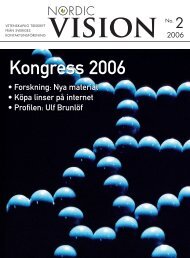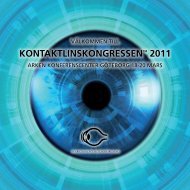Nordic Vision - nr 5 2006 - Sveriges Kontaktlinsförening
Nordic Vision - nr 5 2006 - Sveriges Kontaktlinsförening
Nordic Vision - nr 5 2006 - Sveriges Kontaktlinsförening
You also want an ePaper? Increase the reach of your titles
YUMPU automatically turns print PDFs into web optimized ePapers that Google loves.
KONTAKTOLOGI<br />
When Thinner is not Better<br />
Often in life we are conditioned to<br />
think that thinner is better, but this sentiment<br />
does not apply to the cornea. Th e<br />
thinner cornea is sometimes liable to become<br />
ecstatic, leading to distorted and poorer<br />
vision . Th e cornea has an important function<br />
in acting as an ultraviolet radiation (UVR)<br />
fi lter to protect ocular components. Th e thinning<br />
of the cornea, as occurs with some<br />
diseases and certain refractive surgeries, may<br />
interfere with this function.<br />
In keratoconus, pellucid marginal degeneration<br />
and other corneal thinning disease,<br />
we do not know what is lost when the cornea<br />
becomes thinner. Clinically we observe this<br />
as a stromal thinning. However, what is lost<br />
in the cornea and where precisely it starts<br />
remains a mystery.<br />
Research in our laboratory fi rst had to<br />
focus on developing a more precise understanding<br />
of the normal human cornea. To<br />
determine if we with disease lose stromal<br />
lamellae, we needed to establish how many<br />
there should be in the fi rst place. By using<br />
technology with ultimate resolution, transmission<br />
electron microscopy , we have for<br />
the fi rst time established that the human cornea<br />
contains an average of 242 lamellae and<br />
I England har minst fem procent av<br />
patienterna som besöker en optometrisk<br />
praktik med stor andel förstagångskontroller<br />
av barn, någon form av binokulär avvikelse.<br />
Nästan alla barn i England får sin första<br />
ögonundersökning utförd av en optometrist,<br />
som i normalfallet har en vidareutbildning<br />
i ämnet.<br />
Den vanligaste orsaken till ett binokulärt<br />
problem, är amblyopi i förening med anisometropi,<br />
men vanliga orsaker är också okompenserad<br />
heterofori och strabism. Barn som<br />
har den förstnämnda anomalin har stora<br />
möjligheter att bli behandlade enbart genom<br />
att använda kontaktlinser. Genom introduktionen<br />
av de nya silikonhydrogelmaterialen<br />
och därmed kontaktlinser som kan användas<br />
dygnet-runt i upp till trettio dygn, har ett<br />
34 NORDIC VISION 5·<strong>2006</strong><br />
that this value does not vary a great deal<br />
be tween humans.<br />
If corneal ectasia is the result of weakening<br />
of the cornea, where then is the weakening<br />
located? In LASIK, for instance, anterior<br />
lamellae are severed, and in some cases this<br />
leads to corneal ectasia. Is there something<br />
related to the arrangement of anterior lamellae<br />
that provides a vital structural strength to<br />
the corneal shape? Almost without exception<br />
lamellae are described in literature as cross ing<br />
the cornea limbus to limbus. Our research has<br />
provided clear evidence suggesting that<br />
anterior lamellae, oft en if not always, stop<br />
short of providing a limbus to limbus bridge.<br />
We have yet to determine whether this new<br />
fi nding relating to the lamellar architecture<br />
evolved for structural or optical purposes.<br />
Histopathological examination of keratoconic<br />
corneas has revealed that the focus of<br />
this disease is the anterior cornea. At least in<br />
relatively early stages the posterior stroma,<br />
posterior limiting lamina and endothelium<br />
are of normal appearance, but signifi cant<br />
changes are present in the epithelium, anterior<br />
limiting lamina (ALL) and anterior stroma .<br />
Th e ALL is absent over signifi cant corneal<br />
areas and the anterior stroma harbors<br />
genombrott i behandlingen skett. En besvärande<br />
amblyopi kan i vissa fall reduceras bara<br />
genom användning av kontaktlinser. Det<br />
kan visa sig att det inte alls behövs någon<br />
ocklusionsbehandling.<br />
En anisometropi kan antingen vara refraktiv<br />
eller axial. Den teori som har talat för<br />
användning av glasögonkorrektion i stället<br />
för linser, är att aniseikonin vid axial anisometropi<br />
reduceras genom den större förändringen<br />
av näthinnebilden i det mer felsynta<br />
ögat. Förutsättningen är att näthinnans<br />
receptorer är jämnt fördelade i respektive<br />
näthinna, trots skillnad i yta, vilket inte är<br />
troligt. I praktiken har det visat sig att kontaktlinser<br />
har andra fördelar som gör att<br />
patienterna föredrar dessa. Exempelvis ett<br />
normalt perifert seende, inga prismadiff e-<br />
activated cells together with a noticeable<br />
thinning in the central ecstatic area. Our<br />
future work will assess the number of lamellae<br />
present in the cone and compare that to<br />
the periphery of the same cornea and also<br />
that of the healthy human cornea. Although<br />
the focus of the disease is in the ALL and the<br />
anterior stroma it may still be a disease originating<br />
and orchestrated from the epithelium.<br />
Future treatments, or even cures, of pathological<br />
thinning disease require that we<br />
understand what is lost and where it starts.<br />
An interesting result of our research on the<br />
UVR eff ects on the ocular components has<br />
shown that, contrary to popular opinion, all<br />
corneal UVR absorption is not occurring in<br />
the epithelium. A signifi cant amount of corneal<br />
UVR absorption takes place in the stroma.<br />
It follows that thinning of the stroma will<br />
allow more UVR and also more toxic shorter<br />
wavelengths through this tissue to bombard<br />
internal ocular structures, where the crystalline<br />
lens will be the primary recipient. Th is<br />
leads to the question: are eyes with thinner<br />
corneas prone to develop cataract earlier?<br />
Unlike the body as a whole, thinner is not<br />
healthier for the cornea and the eye.<br />
Jan Bergmanson<br />
Ortoptiska skäl att använda kontaktlinser<br />
renser vid sned blickriktning och en normal<br />
bildåtergivning.<br />
Stewart et al undersökte barn mellan 3 och<br />
8 år, med tidigare obehandlad amblyopi och<br />
fann att i 22 procent av fallen försvann amblyopin<br />
enbart genom kontaktlinskorrektion.<br />
Ingen ocklusionsbehandling var nödvändig.<br />
Den etablerade uppfattningen är att<br />
amblyopi bör behandlas före sju års ålder, då<br />
receptiviteten är som störst. Denna insikt<br />
tycks gälla amblyopi vid strabism, men fl era<br />
studier de senaste åren har visat att amblyopi<br />
på grund av anisometropi kan behandlas<br />
oberoende av patientens ålder.<br />
(Bruce J.W. Evans, Institute of Optometry,<br />
Department of Optometry and Visual Science,<br />
City University, London. Contactlens & Anterior<br />
Eye, September. <strong>2006</strong>).







